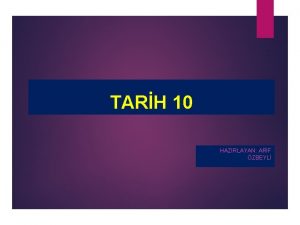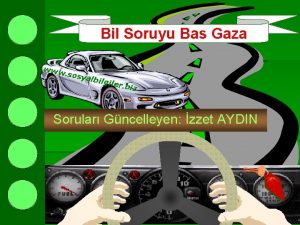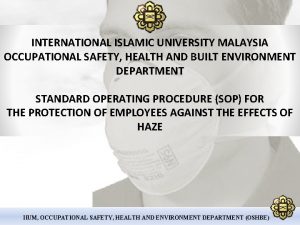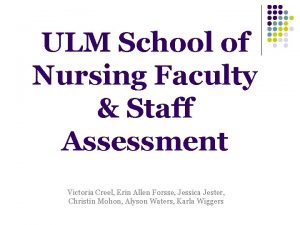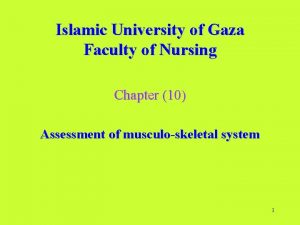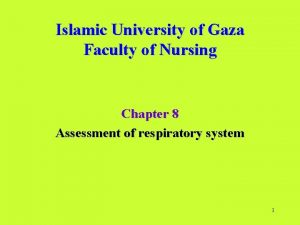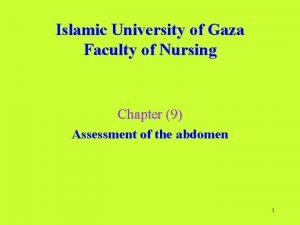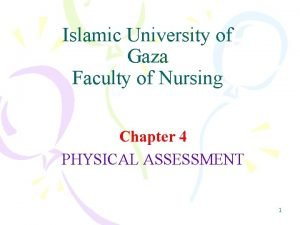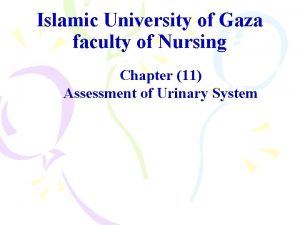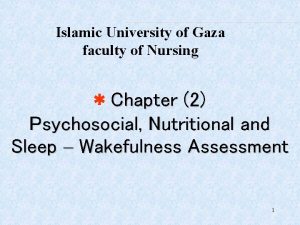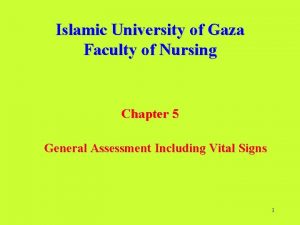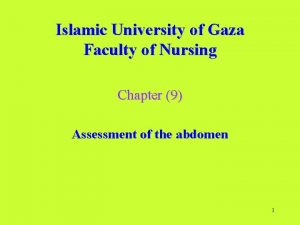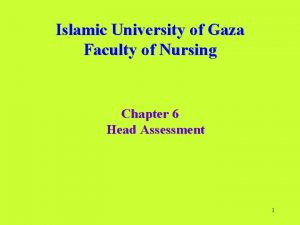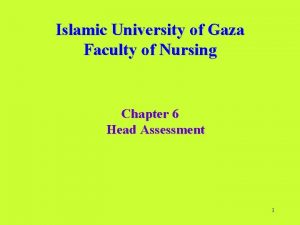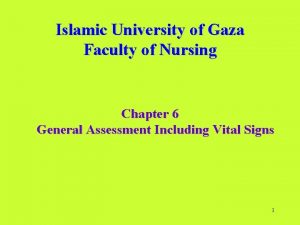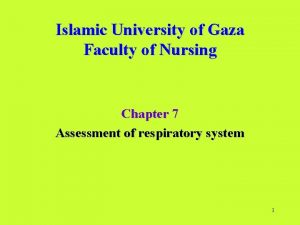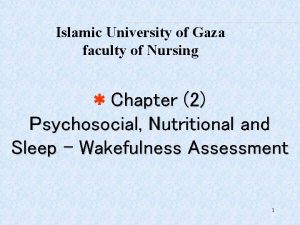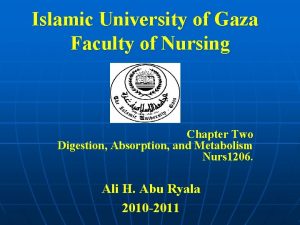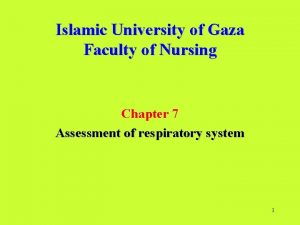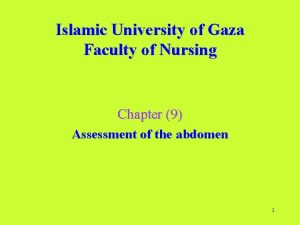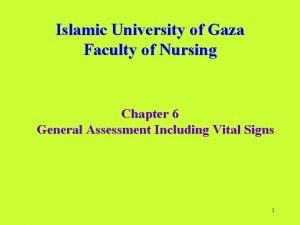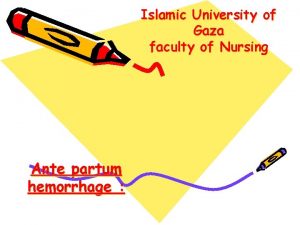Islamic University of Gaza Faculty of Nursing Chapter



































- Slides: 35

Islamic University of Gaza Faculty of Nursing Chapter 6 Head Assessment 1

Head assessment Inspects for size, shape, and contour of head. The skull is generally round with anterior & posterior prominences. Large infant's head may be hydrocephalus. Large adult's head & facial bones resulting from acromegaly. Palpates the skull for nodules or masses 2

Assessment of the eye 3

Assessment of the eye Eye chart (Snellen chart) Chart or newsprint. Cover card. Penlight, ophthalmoscope Ask your client about: History of previous eye surgery, trauma, use of corrective glasses or contact lenses, blurred vision, Diplopia, strabismus. Recent changes in vision. Date of previous vision test. Allergies, eye redness, frequent watering discharge 4

Assessment of the eye cont. . Assess: - External eye structures, pupils, and iris, visual acuity, ocular movements, Peripheral vision. - Internal eye structures e. g. iris , retina, macula etc. ** Consider the following Factors: age use of corrective lens, artificial eye, allergies, pain, visual disturbances, and health related factors such increase Blood Pressure, or Diabetes mellitus 5

Assessment of external eye structures: position and alignment of eyes, eye brow, eye lids, eye lashes, lacrimal glands, pupils and iris. ** Assessment of pupils done by using penlight which produce constriction of pupils. ** Assessment must do for accommodation and convergence of pupils. 6

Assess Visual Acuity: - Done by placing the client 6 meters from the Snellen eye chart and testing each eye alone. ** Assess extra ocular movements: - By asking client to hold his head and follow movements of your forefinger. *Assess peripheral vision: “Visual fields” - Hemianopsia: blindness of 1/2 field in one or both eyes. - Quadrantanopsia: blindness of 1/4 of visual field in one or both eyes. - Ascotoma: Island like blindness in visual field 7

8

Eye Pathologies Orbital Hematoma Orbital fractures (Blowout fracture) Ruptured Globe Corneal Abrasion Corneal Laceration Hyphema Iritis Detached Retina Conjunctivitis Hordeolum Periorbital Lacerations Foreign Bodies Contact Lens Removal 9

Ear Assessment Ask about : -History of ear surgery, trauma, frequent infection, ear pain, drainage, hearing loss, tinnitus, vertigo, ototoxic medications, last hearing examination Assess client in sitting position & inspects the auricle’s placement, size, symmetry, and color. Color of ears must be the same as of the face. Redness: sign of inflammation or fever. Pallor: indicate frost bite. palpate the auricles for texture, tenderness, and skin lesion. 10

Ear assessment cont. … If client complains of pain: pull the auricle and press on the tragus and behind the ear over the mastoid process if pain increase, means external ear infection, if pain is not increase, means middle ear infection may be present. Inspection of ear canal for size and discharge. Assessment of cerumen if it is yellow or green may indicate infection. Assessment of hearing acuity: done simply by identification of voice tones, with the client repeating testing words spoken by the nurse **N. B: deeper structure and middle ear can 11

12

The Otoscope Examination Using the Otoscope : choose the largest speculum head toward the opposite shoulder pull adult ear : pinna upper and back pull infant and child ( <3 age ) : pinna down hold the otoscope : upside down 13

The Otoscope Examination cont. . The External Canal : redness / swelling / lesion / foreign body / discharge Tympanic Membrane : color / character / perforation shiny , translucent , pearl-gray color Cone-shaped light reflex 14

Assessment of the nose Functions of the nose Identify odors (upper 1/3 of septum) Air passageway (obligate in newborns) “Air conditioning” ◦ Humidify ◦ Warms/cools air ◦ Cleans and filters air of dust and most bacteria ◦ Voice resonance 15

Inspect and Palpate Eternal Nose 1. Assess symmetry, nostril, skin lesion. 2. Patency : each time test one side 16

Assessment of the Nose cont. . Inspect & observe symmetry, inflammation, & deformity. In case of swelling or deformities of nose, the nose is palpated gently for tenderness, swelling and underlying deviations. * Normally the external nose is symmetrical, strait, non tender, and without discharge. Assess mucosa which is normally pink in color. Yellowish or greenish discharge – means sinus infection. Pale mucosa with clear discharge – means allergy. N. B: For client with NGT nurse routinely checks for local breakdown of skin “Excoriation” of the naris characterized by redness and sloughing of the skin 17

Assessment of the sinuses 18

Palpation for the sinus areas frontal sinus below the eyebrow maxillary sinus below cheekbones Transillumination sinusitis: 1). frontal sinus under the superior orbital 2). maxillary sinus inside the mouth on the hard palate normal light up symmetrically Transillumination is the transmission of light through tissues of the body. A common example is the transmission of a flash of light through fingers, producing a red glow. This is because red blood cells absorbed other colors of the beam and transmitted only the red component 19

Palpate sinuses 20

Transillumination-Frontal& Maxillary Sinuses 21

Assessment of the sinuses Frontal and maxillary sinuses are examined for pain and edema. - palpate sinuses (both frontal and maxillary for tenderness, which verbalized by client during exam. - Percuss sinuses for resonance which is normally hollow tone, and noting abnormality e. g. flat, dull tone elicited or expresses pain on percussion. 22

Assessment of Mouth and pharynx Anatomy of the mouth 23

Assessment of oral cavity can be made during administration of oral hygiene. Lips – inspected for color, texture, hydration, contour, and lesions. Inner and buccal mucosa, Gums and teeth inspected for color, hydration, texture and lesions e. g. ulcers, abrasions or crusts. Tongue and floor of mouth can carefully inspect. Assessment of palate “soft and hard” by extending client’s backward, assessment for color, shape, texture, and extra bony prominences or defects 24

Assessment of Pharynx Assessment for pharynx done: by using tongue depressors. Pharyngeal tissues are normally pink and smooth. Edema, ulceration, or inflammation indicates infections or abnormal lesions. 25

Assessment of Neck Client in sitting position: assessment done by inspection and palpation. Assess neck muscles, trachea, thyroid gland, carotid arteries and jugular veins, cervical lymph nodes and cervical vertebrae. Assess neck size and position of trachea and thyroid 26

Assess range of motion by asking the client to tilt the head backward and side to side Assess lymph nodes and venous distention. Neck should be symmetrical with full range of motion. No neck vein distention should be visible. Inspect and palpate cervical vertebrae On the posterior aspects of the neck for symmetry, tenderness, masses or 27

Thyroid gland is assessed by palpation, observation and auscultation. Normal thyroid gland not palpable. - Palpation – for gland itself. - If enlargement of thyroid gland is detected, the area over the gland is auscultated for a bruit Bruit: vibrations& sound of blood flow through arteries In enlarged gland, heard with the bell of stethoscope 28

Thyroid dysfunction changes in sleep pattern e. g. fatigue, drowsiness, lethargy, or insomnia. Emotional disturbances: e. g. mood changes, irritability, nervousness. hair loss brittleness of nails. Altered sensitivity to heat or cold. dyspnea on exertion , tachy cardia. changes in appetite: weight loss, abnormal bowel habits. . . etc. changes in menstruation. hoarseness , difficulty swallowing …. etc. History of radiation for to head or neck. 29

Trachea normally centered; (at the supra-sternal notch) The cartilages should be smooth, non tender and move easily under examiner’s fingers when the client swallow. * Palpation done by placing the thump and forefinger on each side of the trachea 30

Assessment of the lymphatic system Functions of lymphatic system 1. Movement and transportation of lymphocytes 2. Production of lymphocytes. 3. Production of antibodies. 4. Phagocytosis 5. Absorption of fat and fat soluble substances. Enlargement of lymph node: provides early indication of infection or malignancy. Lymphatic System consists of a network of collecting ducts, lymph fluids e. g. spleen, thymus, tonsils, adenoids--- etc 31

Examination of lymphatic System : 2 steps - firstly inspection for enlarged lymph nodes, skin lesions, edema, erythematic, and red streaks on the skin. - Secondly palpating gently the lymph nodes areas using pads of "2, 3, 4" fingers in gentle circular motion. Press lightly and then increasing pressure gradually. Move skin lightly over the under lying tissues ¬ moving the examining fingers over the skin. NB. Large nodes due to malignancy are generally not tender vary in size, hard, asymmetrical 32

some Areas of lymph nodes Pre auricular: in front of the ear. Mastoid or posterior auricular – behind the ear. Above the mastoid process. Occipital – at the base of skull posterior. Parotid – near the angle of the jaw. Sub-mandibular – midway between angle of jaw and the tip of the mandible. Sub mental – in the midline posterior to the tip of the mandible. Anterior superficial nodes – in the anterior triangle of the neck. 33

some Areas of lymph nodes cont. . Posterior cervical nodes – in the posterior triangle of the neck. Deep cervical nodes – very deep and difficult to be examine. Supra clavicular or scalene nodes – In the angle formed by clavicle and Sternocleidomastoid muscle. ** Axilla, breast &Lower extremity (inguinal and popliteal nodes) 34

The end Thank you 35
 Sınıfı
Sınıfı Pakimires
Pakimires Bil soruyu bas gaza
Bil soruyu bas gaza Gaza strip map
Gaza strip map Gaza strip map
Gaza strip map Mapa franja de gaza
Mapa franja de gaza Palestina e israel mapa
Palestina e israel mapa Gaza central desalination plant
Gaza central desalination plant Dzsenin
Dzsenin Oshbe
Oshbe Islamic university college
Islamic university college Mrbs scholarship
Mrbs scholarship Ulm nursing faculty
Ulm nursing faculty University of split faculty of maritime studies
University of split faculty of maritime studies University of bridgeport computer science
University of bridgeport computer science University of bridgeport computer engineering
University of bridgeport computer engineering Hubert kairuki memorial university faculty of medicine
Hubert kairuki memorial university faculty of medicine Semmelweis university faculty of medicine
Semmelweis university faculty of medicine King abdulaziz university faculty of medicine
King abdulaziz university faculty of medicine Florida state university computer science
Florida state university computer science Mendel university - faculty of business and economics
Mendel university - faculty of business and economics Singularity university faculty
Singularity university faculty Territorial matrix vs interterritorial matrix
Territorial matrix vs interterritorial matrix Masaryk university medical faculty
Masaryk university medical faculty Feup university of porto
Feup university of porto Charles university humanities
Charles university humanities Faculty of veterinary medicine cairo university logo
Faculty of veterinary medicine cairo university logo Faculty of law of the university of zagreb
Faculty of law of the university of zagreb University of montenegro faculty of law
University of montenegro faculty of law University of kragujevac faculty of technical sciences
University of kragujevac faculty of technical sciences University of cologne faculty of management
University of cologne faculty of management Leading university sylhet tuition fees
Leading university sylhet tuition fees Hacettepe university faculty of medicine
Hacettepe university faculty of medicine Brown university computer science faculty
Brown university computer science faculty Dosrsal
Dosrsal Semmelweis university faculty of medicine
Semmelweis university faculty of medicine

